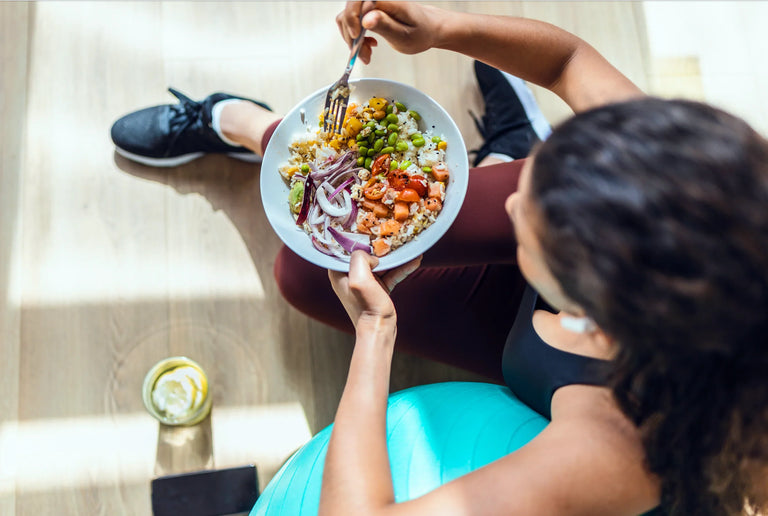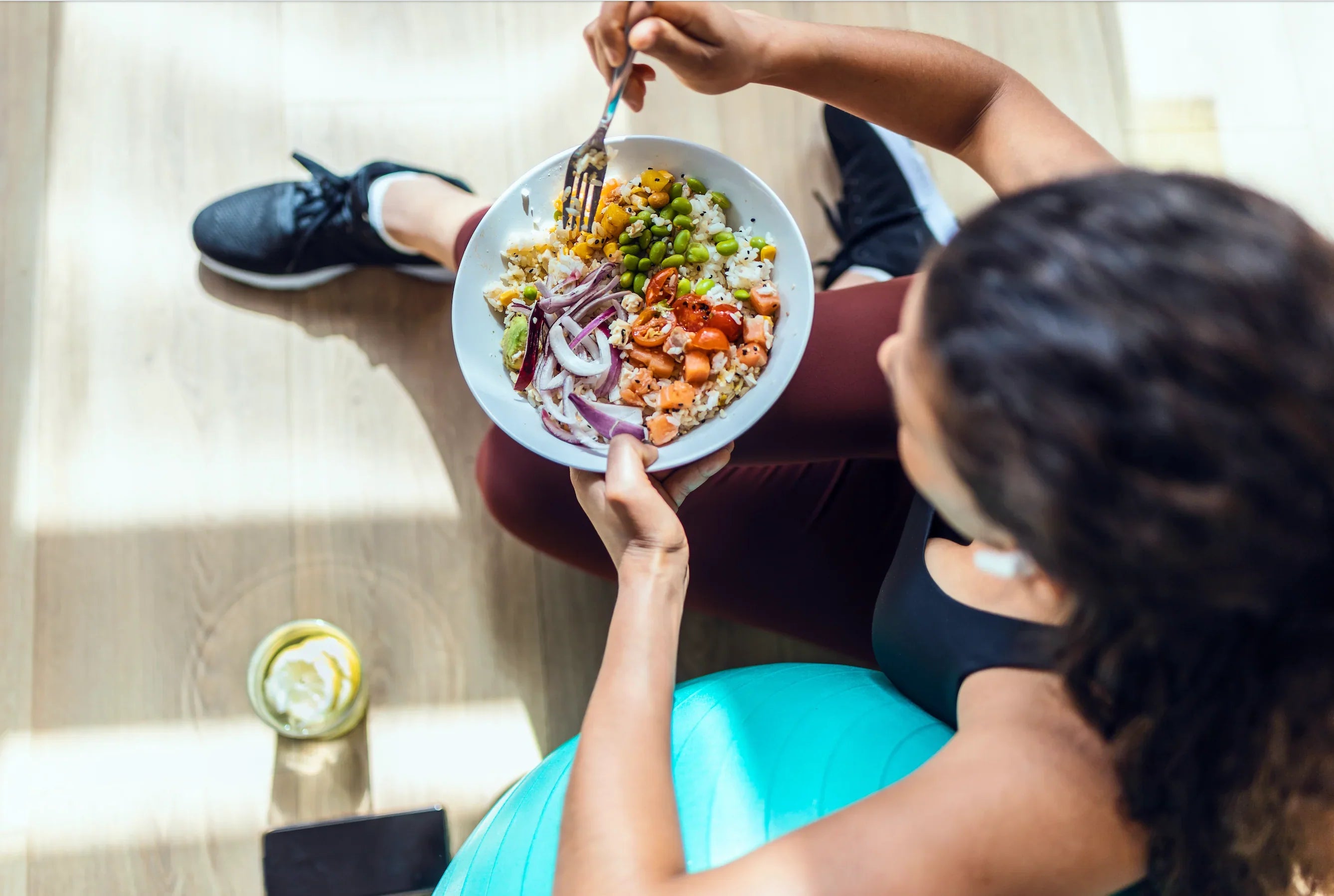I’ve always thought the phrase, “Watch what you eat” was rather silly. Watch it do what? Watch my In-N-Out burger and shake go delightfully down into my belly?
You may have gotten this advice from your physician or a personal trainer. But what are you supposed to do with that advice? Do you know how exactly to go about monitoring your food intake? Last time I talked about whether or not counting macros was right for you. In this blog, we’ll look at two other options when it comes to nutrition intake strategies.
The beautiful and difficult part is that any strategy you’ve heard of works– for someone. But does it work for you? Let’s consider intuitive eating and calorie counting.
Intuitive Eating
You may read the words “intuitive eating” and give a big eye roll. And really, I can’t blame you. It’s usually followed up by phrases like, “Listen to your body” or “Follow your hunger cues.” Which on the outside sounds sweet, but offers zero direction.
But what if I told you intuitive eating may actually work for you? Being aware of your body and how your diet can affect it is critical– both for getting fit and for having a healthy relationship with food. When you’re able to self-regulate, it gives you more freedom and flexibility than counting macros. One study suggests that following intuitive eating strategies may even give you more confidence and motivation to reach your nutritional goals (Sairanen, 2017).
My go-to strategy for learning how to “listen to your body” is to keep a food journal. But this isn’t just listing out what you ate. It’s taking that list and adding other factors like: time, location, who you’re with, why you’re eating, how you feel, what you’re thinking about, etc. It sounds silly at first, but understanding things like who you’re with can help illuminate why you eat what you eat or how much you eat.
For example, I have a friend who is in full training mode for a 50k in Sinks Canyon, Wyoming. She is dedicated to her training plan and fueling herself properly for it. She recently took a trip home to visit her family. When she came back, she mentioned feeling low-energy, inflamed, and like she was in a fog. She said that she kept up with her training so it must have been cross-country travel causing her issues. Upon reflection, she was able to see that being with her family was a stressful occasion that led to overeating and consuming foods that did not serve her body well. When we’re able to jot these circumstances down, we can then guide ourselves back toward foods that are working toward our goals. This kind of food journal illuminates our mind to understand what motivates us and if there are any patterns we need to break.
The next strategy goes along well with the food journal and that is being aware of how the food you’re about to eat or have just eaten is making you feel. Is the food triggering to you? How does it settle in your gut? This can help bring to light any intolerances you may have toward food. Even though a food may be nutritionally dense, it may still be inhibiting you from your goals as it may not agree with your body.
Making these two strategies a regular practice takes time and effort. I suggest starting small and building. Maybe start with 1-3 days per week. Once the task does not seem so daunting, you can begin to add more days. However, the goal is not to have to keep this up for forever. The goal is to master the task so well that you can quickly work it out in your head, rather than have to spend time writing it down.
I could go on about intuitive eating, but I’ll just say one more thing. Intuitive eating is about slowing down. I know, crazy talk! We live in a fast-paced world– to say the least. Most of us are scarfing down our food to get on to the next thing. Studies have shown, however, that if we slow down our eating, we can find improved digestion and actually understand when our body is satisfied (Andrade, 2008). This can mean decreased portion sizes as well. Helpful for losing or maintaining weight if that is your goal.
Calorie Counting
The words “calorie counting” may also invoke some strong feelings of dread or anxiety. But research has shown that, if done accurately, it works. If anything we can all agree that it is precise and informative to how many calories you’re actually consuming. It can also be helpful if you’re an athlete who needs that kind of precision or you’re just a numbers-oriented person.
However, if you’re like most of us, calorie counting is a less than ideal strategy for staying on top of your nutrition. While I mentioned that research suggests it works, it also shows that it doesn’t last long (Turner-McGrievy, 2019). Calorie counting is, in my opinion, a guaranteed way to suck the joy out of food. It makes eating out or with friends a challenge. It has also been known to lead to binge eating and putting moral value on food– “good” vs “bad” food.
It may sound like I’m ragging on calorie counting, but it can be a useful strategy for folks who are able to stay curious and find the precision empowering. But if you’re finding it overwhelming, anxiety-inducing, and taking up much of your time, it may be time to try another strategy. Besides, we want to make sure we’re acknowledging where the calories come from. Just because you have met the number does not mean that you actually took in nutrient-dense foods.
As I mentioned in my blog about tracking macros, I like to use the Hand Size Portion method adopted from Precision Nutrition. It goes like this:
-
A serving of protein is the size of your palm
-
A serving of carbohydrates is a cupped hand
-
A serving of fat is the size of your thumb
-
A serving of vegetables is the size of your fist (Vegetables are included in this to add micronutrient value)
Remember that you don’t need to follow a rigid plan to be successful—you need a sustainable one. A strategy that helps you feel energized, nourished, and in control without making you dread mealtime. Maybe that means starting with a food journal once a week or simply slowing down at dinner to notice how you feel. Maybe it means trying calorie counting for a season and then easing into a more intuitive rhythm.
Whatever path you choose, give yourself room to experiment. Nutrition is not one-size-fits-all—and that’s the beauty of it. Try things out and adjust as you go. And remember: the goal isn’t perfection—it’s progress.
So go ahead—watch what you eat. Not with guilt or pressure, but with curiosity, care, and intention.
References
Andrade, A. M., Greene, G. W., & Melanson, K. J. (2008). Eating slowly led to decreases in energy intake within meals in healthy women. Journal of the American Dietetic Association, 108(7), 1186–1191. https://doi.org/10.1016/j.jada.2008.04.026
Sairanen, E., Tolvanen, A., Karhunen, L., Kolehmainen, M., Järvelä-Reijonen, E., Lindroos, S., Peuhkuri, K., Korpela, R., Ermes, M., Mattila, E., & Lappalainen, R. (2017). Psychological flexibility mediates change in intuitive eating regulation in acceptance and commitment therapy interventions. Public health nutrition, 20(9), 1681–1691. https://doi.org/10.1017/S1368980017000441
Turner-McGrievy, G. M., Dunn, C. G., Wilcox, S., Boutté, A. K., Hutto, B., Hoover, A., & Muth, E. (2019). Defining Adherence to Mobile Dietary Self-Monitoring and Assessing Tracking Over Time: Tracking at Least Two Eating Occasions per Day Is Best Marker of Adherence within Two Different Mobile Health Randomized Weight Loss Interventions. Journal of the Academy of Nutrition and Dietetics, 119(9), 1516–1524. https://doi.org/10.1016/j.jand.2019.03.012



